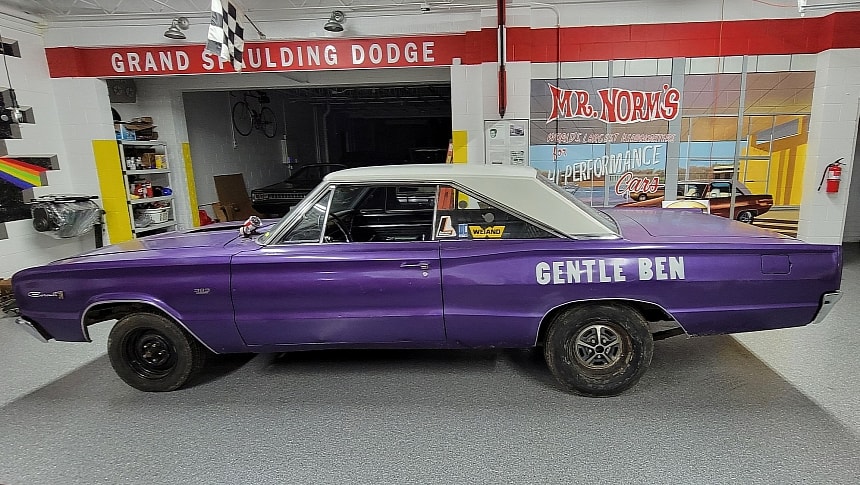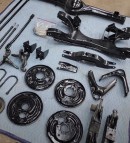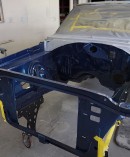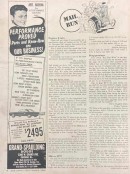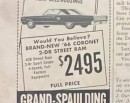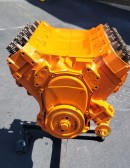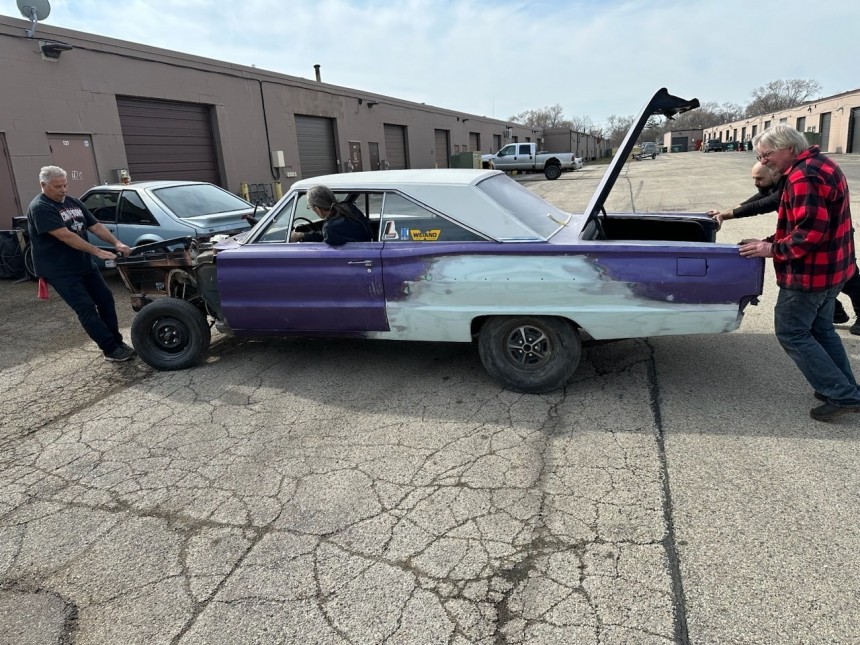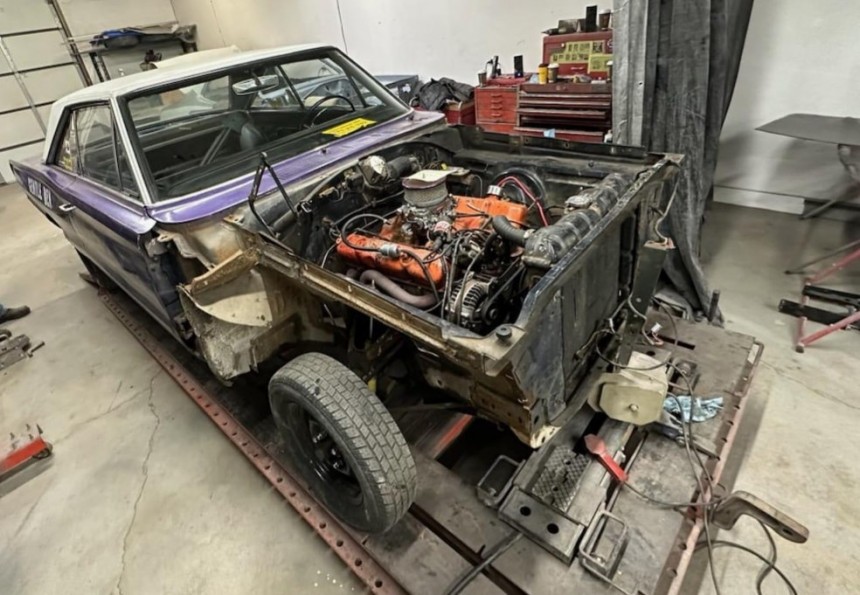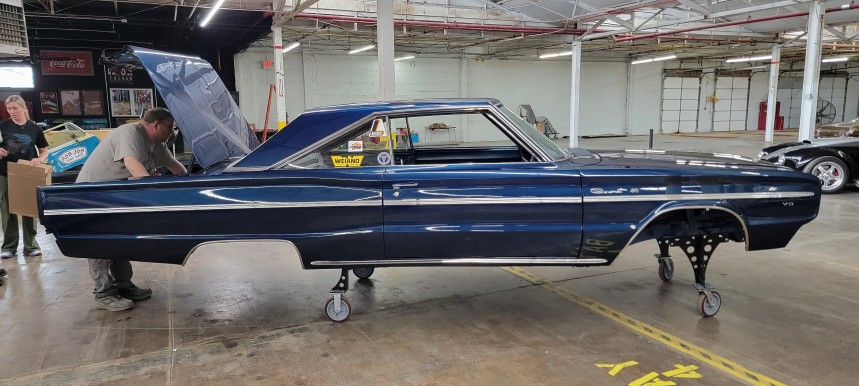In 1966, Dodge took the muscle car market by storm with the 426-cubic-inch (7.0-liter) HEMI. Developed specifically for racing, the mill found its way into production cars for homologation purposes. A legend was born. At the same time, Chrysler discontinued the 426 Wedge. But what if I told you that at least one Dodge left the factory with the HEMI's predecessor for the 1966 model year?
In March 2023, I reported about a 1966 Dodge Coronet that claimed one-of-one status and was advertised as a "Mr. Norm's" car. The Coronet, which had spent decades in storage, raised more questions than answers. At the time, there wasn't sufficient documentation to confirm its status beyond a doubt. However, the rig got a running drivetrain and hit several car shows.
Later that year, I saw footage of the purple Coronet at the Muscle Car and Corvette Nationals (MCACN) but didn't make much of it. I knew the owner wasn't planning on restoring it to its original specifications. As time went on, I almost forgot about the somewhat quirky Mopar.
That changed in May 2024 when I got a message from a gentleman named Jim Wicker. He had purchased the 1966 Coronet and was already elbows deep into the restoration process. I almost dropped my cup of joe. The unicorn was finally getting the attention it deserved. And it's a story you need to know because yet another legend is about to be born.
It's still unclear why Chrysler decided to use the discontinued Wedge in a 1966 Dodge, but Jim speculates it's because the company needed to show NASCAR they would be ready for the said season with a 426-cubic-inch powerplant. Chrysler was having difficulties rolling out the HEMI. However, the latter arrived on time, so Mopar scrapped the plan-B Wedge option.
Noted Mopar expert Galen V. Govier also documented the car's authenticity as a 1966 Wedge. According to him, only three vehicles were special-ordered with the 426 Street Wedge. However, this 1966 Coronet is the only one known to exist. It's also the only unit with extensive documentation from all previous owners.
The previous owner also successfully linked the car to Grand Spaulding Dodge, the iconic performance-oriented dealership that sold the sought-after "Mr. Norm's" vehicles. The vehicle's data card has been recovered, confirming that it shipped to that dealership.
More proof comes from an ad Mr. Norm ran at the time. The print said, "Would you believe? Brand-new '66 Coronet 2-dr Street Ram" with "full factory equipment." The ad confirms the engine wasn't a swamp performed by Mr. Norm Kraus. It seems he was also surprised Dodge fitted a 426 Wedge in a 1966-model-year car.
It wasn't commissioned by the dealership, either. Dodge simply chose to send it to Mr. Norm because they thought he was the only man who could sell such a car. Furthermore, according to Mr. Wicker, the numbers stamped in the core support, rear bumper support, and broadcast sheet "all match and coincide with each other."
He was planning to fix the Street Wedge, but life got in the way, and he sold the car before he got to it. He also crashed the vehicle before selling it, which explains the Coronet 500 front fenders. The first owner also claimed that the Coronet was faster than the other 426 Wedge cars he had, which means Chrysler may have tinkered with the internals. Jim suggests the 426 may have been a Max Wedge under the shell and I don't think it's far-fetched.
The second owner replaced the hood, painted the car purple, and named it "Gentle Ben," bringing it to the condition it was discovered in decades later. He also made several mods to the body and under the hood. The Coronet changed a couple more owners before it ended up in storage in the mid-to-late 1970s. It then went into a storage box, where it remained for decades.
The Coronet was unearthed in 2012. Its fifth owner noticed the discrepancies between the VIN and the fender tag and sold it, thinking it had a misprinted VIN. The sixth owner, who showcased the car in 2023, discovered the broadcast sheet under the rear seat and did the initial research toward unveiling its special-order 426 Wedge status.
After touring it at various events through 2023, the sixth owner sold the 1966 Coronet to Jim, who completed the documentation process. Come 2024, Jim and his team have already spent 700 hours on the car, and it looks like the Coronet is about to become a museum-grade classic.
Despite its racing history, Mr. Wicker wants to restore the Coronet to factory specifications. This will obviously include a change of color because the hardtop did not leave the factory in purple paint. The Coronet was originally finished in Dark Blue Poly (code EE1). Likewise, the black interior was an aftermarket addition. Jim discovered the interior was originally two-tone blue, and he will restore that initial combo.
At the time of our chat, he was still looking for the period-correct radio bezel. Even though the Coronet was built with a radio delete, the bezel was still fitted but lost along the way.
The 426 Wedge is arguably the trickiest element to restore since the original unit is no longer around, and its contents are a bit of a mystery. Luckily enough, since the factory unit would have never been numbered or date-coded for 1966, rebuilding a 1964-1965 426 Wedge is pretty accurate—as long as the block is orange, that is, because this Coronet did not have the usual turquoise mill.
Jim has already sourced and date-coded major components, including the carburetor and intake, and he's restoring the HEMI radiator, water pump housing, and fan found with the car. "I'm putting everything back in as close as correct," he said. He believes Chrysler beefed up the engine with Max Wedge internals, high compression, and a small cam.
The Coronet will leave his shop "at least 90% as delivered by Norm," including the headers added by the dealership. However, Jim says the car will retain some of the mods made under initial ownership. In short, it will be a factory-correct restoration with a hint of its racing days.
When will we see this unicorn in all its glory? Jim plans to unveil it at the 2024 MCACN in late November. So make sure you stick around because there will be a follow-up on this historically significant rig. Meanwhile, you can check out Jim's YouTube channel, "AngryCylinders," for updates on the car.
Later that year, I saw footage of the purple Coronet at the Muscle Car and Corvette Nationals (MCACN) but didn't make much of it. I knew the owner wasn't planning on restoring it to its original specifications. As time went on, I almost forgot about the somewhat quirky Mopar.
That changed in May 2024 when I got a message from a gentleman named Jim Wicker. He had purchased the 1966 Coronet and was already elbows deep into the restoration process. I almost dropped my cup of joe. The unicorn was finally getting the attention it deserved. And it's a story you need to know because yet another legend is about to be born.
What exactly are we looking at?
Seemingly mundane at first glance, this 1966 Coronet is a fully-fledged one-of-one gem. And even though it was born with a factory 426 Wedge V8, it's not exactly a production car either. You see, the 426 Wedge was no longer available at the time, so it's more of a prototype. The unit was hand-built using OEM parts from previous years.It's still unclear why Chrysler decided to use the discontinued Wedge in a 1966 Dodge, but Jim speculates it's because the company needed to show NASCAR they would be ready for the said season with a 426-cubic-inch powerplant. Chrysler was having difficulties rolling out the HEMI. However, the latter arrived on time, so Mopar scrapped the plan-B Wedge option.
Noted Mopar expert Galen V. Govier also documented the car's authenticity as a 1966 Wedge. According to him, only three vehicles were special-ordered with the 426 Street Wedge. However, this 1966 Coronet is the only one known to exist. It's also the only unit with extensive documentation from all previous owners.
The previous owner also successfully linked the car to Grand Spaulding Dodge, the iconic performance-oriented dealership that sold the sought-after "Mr. Norm's" vehicles. The vehicle's data card has been recovered, confirming that it shipped to that dealership.
It wasn't commissioned by the dealership, either. Dodge simply chose to send it to Mr. Norm because they thought he was the only man who could sell such a car. Furthermore, according to Mr. Wicker, the numbers stamped in the core support, rear bumper support, and broadcast sheet "all match and coincide with each other."
From drag racing to long-term storage
The previous owner was able to contact all previous owners, so Jim now has a complete history in the Coronet. Not surprisingly, the first owner drag-raced the car for a few years. He eventually blew the engine in a street race and replaced it with a 383-cubic-inch (6.3-liter) big block.He was planning to fix the Street Wedge, but life got in the way, and he sold the car before he got to it. He also crashed the vehicle before selling it, which explains the Coronet 500 front fenders. The first owner also claimed that the Coronet was faster than the other 426 Wedge cars he had, which means Chrysler may have tinkered with the internals. Jim suggests the 426 may have been a Max Wedge under the shell and I don't think it's far-fetched.
The Coronet was unearthed in 2012. Its fifth owner noticed the discrepancies between the VIN and the fender tag and sold it, thinking it had a misprinted VIN. The sixth owner, who showcased the car in 2023, discovered the broadcast sheet under the rear seat and did the initial research toward unveiling its special-order 426 Wedge status.
After touring it at various events through 2023, the sixth owner sold the 1966 Coronet to Jim, who completed the documentation process. Come 2024, Jim and his team have already spent 700 hours on the car, and it looks like the Coronet is about to become a museum-grade classic.
Factory-correct restoration (for the most part)
After being raced for nearly 10 years and parked for more than four decades, the Coronet re-emerged as an almost rust-free classic. This makes it that much easier to restore, but according to Jim, the process will still reach six digits.At the time of our chat, he was still looking for the period-correct radio bezel. Even though the Coronet was built with a radio delete, the bezel was still fitted but lost along the way.
The 426 Wedge is arguably the trickiest element to restore since the original unit is no longer around, and its contents are a bit of a mystery. Luckily enough, since the factory unit would have never been numbered or date-coded for 1966, rebuilding a 1964-1965 426 Wedge is pretty accurate—as long as the block is orange, that is, because this Coronet did not have the usual turquoise mill.
Jim has already sourced and date-coded major components, including the carburetor and intake, and he's restoring the HEMI radiator, water pump housing, and fan found with the car. "I'm putting everything back in as close as correct," he said. He believes Chrysler beefed up the engine with Max Wedge internals, high compression, and a small cam.
One of the rarest rigs of the golden muscle car era
Jim is uber excited about this project, and rightfully so. This Mopar is among the rarest vehicles of the 1960s. It's part of a very short "production" run that reportedly included only three examples, and his is the only one that has been documented and shown in public. It's also the only 426 Wedge car with an orange block and probably the last Street Wedge Mopar ever built.When will we see this unicorn in all its glory? Jim plans to unveil it at the 2024 MCACN in late November. So make sure you stick around because there will be a follow-up on this historically significant rig. Meanwhile, you can check out Jim's YouTube channel, "AngryCylinders," for updates on the car.
